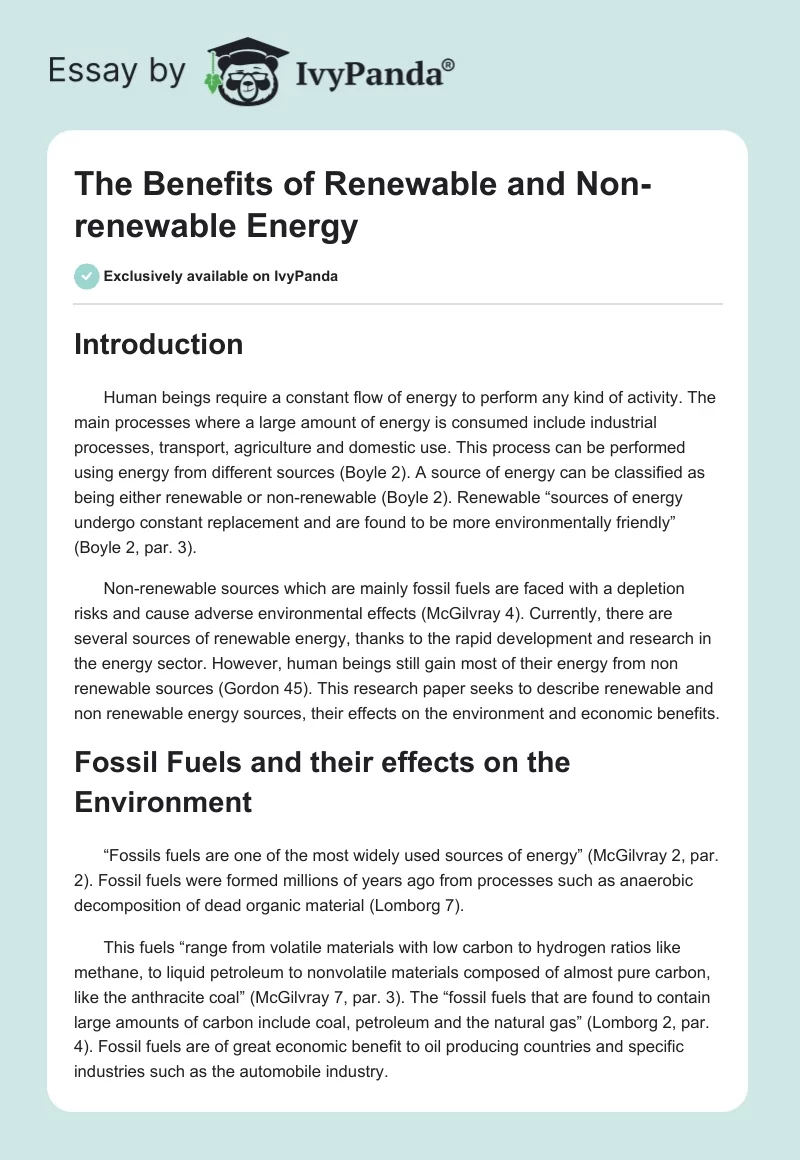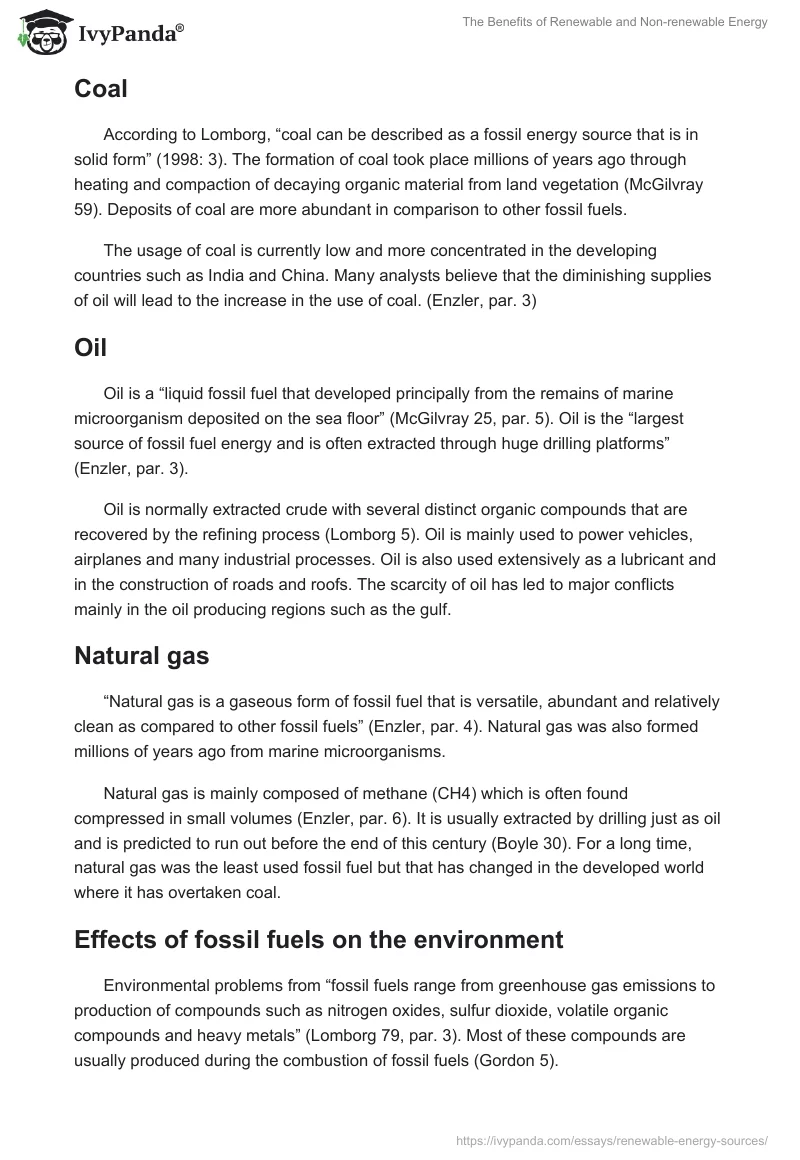Introduction
Human beings require a constant flow of energy to perform any kind of activity. The main processes where a large amount of energy is consumed include industrial processes, transport, agriculture and domestic use. This process can be performed using energy from different sources (Boyle 2). A source of energy can be classified as being either renewable or non-renewable (Boyle 2). Renewable “sources of energy undergo constant replacement and are found to be more environmentally friendly” (Boyle 2, par. 3).
Non-renewable sources which are mainly fossil fuels are faced with a depletion risks and cause adverse environmental effects (McGilvray 4). Currently, there are several sources of renewable energy, thanks to the rapid development and research in the energy sector. However, human beings still gain most of their energy from non renewable sources (Gordon 45). This research paper seeks to describe renewable and non renewable energy sources, their effects on the environment and economic benefits.
Fossil Fuels and their effects on the Environment
“Fossils fuels are one of the most widely used sources of energy” (McGilvray 2, par. 2). Fossil fuels were formed millions of years ago from processes such as anaerobic decomposition of dead organic material (Lomborg 7).
This fuels “range from volatile materials with low carbon to hydrogen ratios like methane, to liquid petroleum to nonvolatile materials composed of almost pure carbon, like the anthracite coal” (McGilvray 7, par. 3). The “fossil fuels that are found to contain large amounts of carbon include coal, petroleum and the natural gas” (Lomborg 2, par. 4). Fossil fuels are of great economic benefit to oil producing countries and specific industries such as the automobile industry.
Coal
According to Lomborg, “coal can be described as a fossil energy source that is in solid form” (1998: 3). The formation of coal took place millions of years ago through heating and compaction of decaying organic material from land vegetation (McGilvray 59). Deposits of coal are more abundant in comparison to other fossil fuels.
The usage of coal is currently low and more concentrated in the developing countries such as India and China. Many analysts believe that the diminishing supplies of oil will lead to the increase in the use of coal. (Enzler, par. 3)
Oil
Oil is a “liquid fossil fuel that developed principally from the remains of marine microorganism deposited on the sea floor” (McGilvray 25, par. 5). Oil is the “largest source of fossil fuel energy and is often extracted through huge drilling platforms” (Enzler, par. 3).
Oil is normally extracted crude with several distinct organic compounds that are recovered by the refining process (Lomborg 5). Oil is mainly used to power vehicles, airplanes and many industrial processes. Oil is also used extensively as a lubricant and in the construction of roads and roofs. The scarcity of oil has led to major conflicts mainly in the oil producing regions such as the gulf.
Natural gas
“Natural gas is a gaseous form of fossil fuel that is versatile, abundant and relatively clean as compared to other fossil fuels” (Enzler, par. 4). Natural gas was also formed millions of years ago from marine microorganisms.
Natural gas is mainly composed of methane (CH4) which is often found compressed in small volumes (Enzler, par. 6). It is usually extracted by drilling just as oil and is predicted to run out before the end of this century (Boyle 30). For a long time, natural gas was the least used fossil fuel but that has changed in the developed world where it has overtaken coal.
Effects of fossil fuels on the environment
Environmental problems from “fossil fuels range from greenhouse gas emissions to production of compounds such as nitrogen oxides, sulfur dioxide, volatile organic compounds and heavy metals” (Lomborg 79, par. 3). Most of these compounds are usually produced during the combustion of fossil fuels (Gordon 5).
Fossil fuels are responsible for the increased concentration of greenhouse gases into the atmosphere. The greenhouse gases usually “absorb infrared light and thus result into additional global warming and thus causing climate change” (McGilvray 55, par. 3). “Carbon dioxide, methane and nitrous oxide” are the main greenhouse gases that are released during combustion of fossil fuels (McGilvray 55, par. 4).
The “combustion of fossil fuels also leads to the generation of sulfuric, carbonic and nitric acids which normally fall on earth as acid rain” (Gordon 2, par. 3). Acid rain affects vegetation, water surfaces and aquatic life, automotive coatings and buildings. “Fossil fuels are also found to contain radioactive materials which are mainly uranium and thorium” (Gordon 4, par. 3).
These radioactive materials are usually released into the atmosphere. However, the concentration of radioactive material that is released directly from fossil fuels is still negligible to cause any harmful effects.
According to McGilvray, “harvesting processing and distribution of fossil fuels can also create environmental concerns” (2003: 7). Coal mining and oil drilling often lead to fire hazards that destroy the immediate environment (Lomborg 75). Offshore oil drilling poses hazards to aquatic life through oil spillages and the resulting pollution (Lomborg 36).
Renewable Sources of energy
Renewable sources of energy include all “energy sources that are captured from on-going natural processes such as solar, wind, radiation, and water flow, biomass and geothermal” (Boyle 2, par. 2). These sources can be used directly to produce energy or may be used to produce other more friendly energy forms. The renewable sources of energy include; hydrogen, wind, biomass, solar energy, geothermal and hydro electric energy (Boyle 3).
Hydrogen
Hydrogen is both a renewable and a non renewable source of energy. It can be described as non renewable when used for nuclear fusion although this technique is not yet fully developed for power generation mechanism (Boyle 30).
It can be identified as a renewable source when it is “used as an energy carrier for oxidation, for instance, in a fuel cell and internal combustion engine” (Boyle 32, par. 6). Hydrogen releases high amounts of energy and does not cause significant environmental pollution. NASA uses liquid nitrogen to power space shuttles and other rockets into orbit (Boyle 32).
Wind
Wind is one of the oldest sources of energy. The power from wind was initially captured using large sail-blades and was utilized for pumping water or driving small mills. Newer windmills have much “smaller, faster turning, more compact units with more blades” (McGilvray 102, par. 4).
Following the increased advocacy for renewable energy there has been development of power generation farms by mainstream power firms (Lomborg 76). For power generation, the blades are often large positioned high and are fewer, mostly three or two and slow moving (McGilvray 103). Blades for power generation are usually positioned in strategic locations where wind movement is un-interrupted.
Biomass
Biomass produces power through various processes. The oldest method of getting energy from biomass is burning it to release heat energy such as the in the 19th century steam engines. Recently, there has been development of more efficient and cleaner ways of using biomass (Boyle 116). It can be converted into liquid fuels, for example, or “cooked” in a process “gasification” to produce combustible gases, which reduces various kinds of emissions from biomass combustion, especially particulates (McGilvray 78, par 4).
Bio-mass can be mixed with coal to produce energy in a process referred to as co-firing. Another common mode of biomass power production is through anaerobic digestion where micro-organisms break down biomass to produce methane and carbon dioxide (Lomborg 56). The sustainability of biomass as an alternative source of energy has been faced with many challenges mainly due to the environmental risks such as depletion of vegetation cover and carbon dioxide production.
Solar energy
“Solar energy refers to the conversion of sunlight to electricity, either directly using photovoltaics (PV) or indirectly using concentrated solar power systems” (Boyle 68, par. 3). The PV uses the principle of photoelectric effect to produce electric current from sunlight (Boyle 68).
The first commercial solar power generation plant was installed in 1980. Early development of solar power can be traced to 1960s and was triggered by the fear that coal would be depleted. Recent developments in solar energy have been witnessed as a result of increased advocacy for “green” energy (Boyle 86, par. 7). The advantage of solar energy is that it is available in small units for individual or residential use.Geothermal
Geothermal electricity is “produced when a wheel that is turned using hot gases vented from fissures in the earth’s crust rotates a dynamo on a generator” (McGilvray 17, par. 5). The limitation of this power source is that it is not found all over the world and some of the potential areas include Italy, New Zealand, Italy and United States among other areas (McGilvray 17).Currently, “there are studies on how underground water can be pumped to hot areas of the earth’s crust for the purpose of power generation” (Boyle 35).
Hydro electric energy
Hydro power electricity refers to the production of power using turbines that are turned by the force of water from dammed rivers. Hydro-power generation option does not produce any carbon dioxide but causes significant risk to aquatic habitats.
For instance, there has been a debate on the effects of dams on salmon runs in the US. Currently, hydropower contributes around 19% of the entire world’s electricity and is often applied to peak load demand, because it is easy to stop and start (Boyle 44). The future for hydropower generation looks bleak due to lack of more sites for construction of dams or other restrictions such as environmental considerations.
Benefits of renewable energy
Renewable sources of energy have varied effects and benefits depending on the particular type and the technologies involved. The most obvious benefit of renewable energy is that they cannot be exhausted. They are also “clean in most cases and thus don’t contribute significantly to environmental pollution and global warming” (Lomborg 34).
Most of the renewable energy sources such as solar, geothermal and hydro are naturally occurring and thus fewer costs are incurred in their operation and maintenance. Solar energy units are particular cheap to install as they can be fitted on existing buildings (Enzler, par. 8).
Commercial production of renewable energy is more expensive as compared to the non-renewable alternative. For instance it is very expensive to install a commercially viable solar or wind power unit. However, renewable energy is cheap when the environmental effects of non-renewable energy are considered.
Conclusion
This research paper sought to describe renewable or non renewable energy sources, their effects on the environment and economic benefits. It has been established that non renewable source of energy is easily accessible but pose a significant risk to the environment and are faced with depletion risks. On the other hand renewable sources cannot be depleted, are environmentally friendly in most cases but more expensive (Boyle 132).
Works Cited
Boyle, George. Renewable Energy: Power for a Sustainable Future. London: Open University, 1996. Print.
Enzler, Simon. “Kyoto: Trading emissions permits”. lenntech.com. 2 January 2006. Web. <https://www.lenntech.com/greenhouse-effect/kyoto-emissions-trading.htm>.
Gordon, James. Nuclear Proliferation through coal burining . Ohio : Ohio State University, 2009. Print.
Lomborg, Brian. The Skeptical Environmentalist – Measuring the Real State of the World. Cambridge : Cambridge University Press, 1998. Print.
McGilvray, Perman. Natural Resource and Environmental Economic. Harlow: Pearson Education, 2003. Print.


